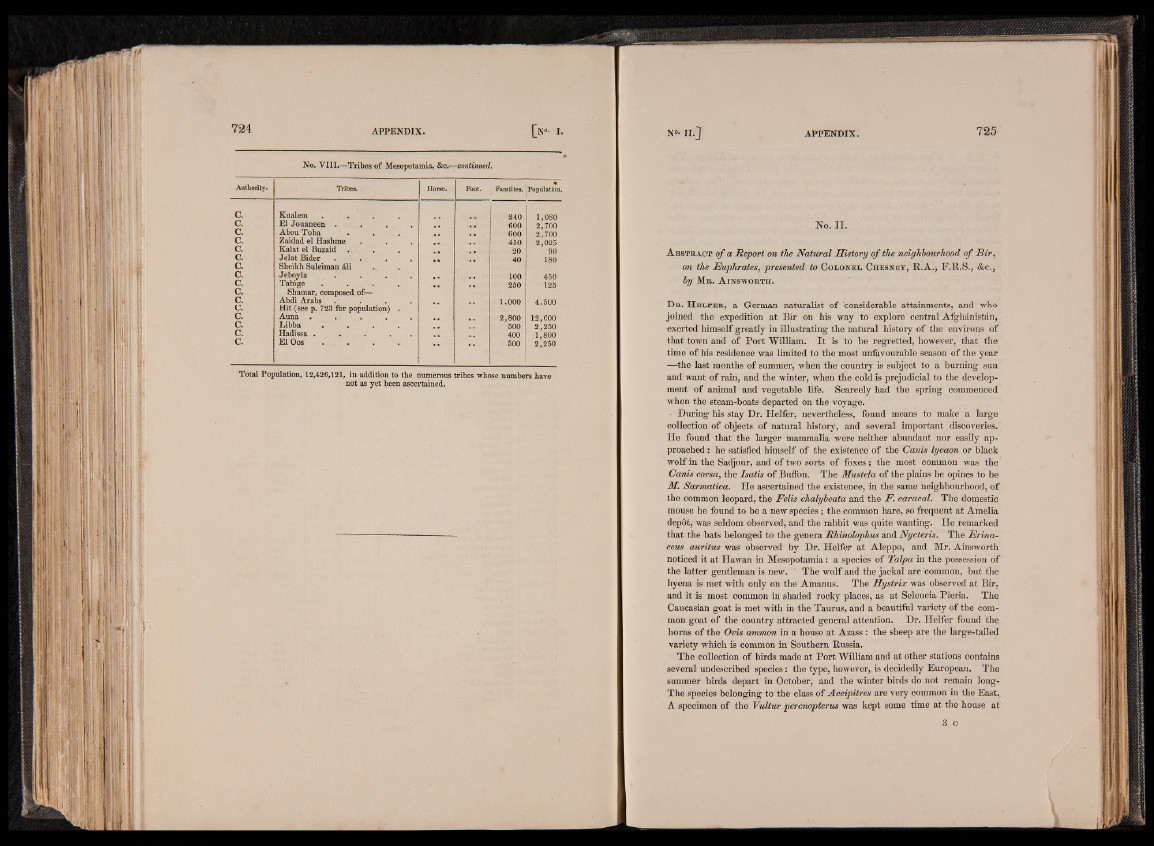
724 APPENDIX. [u - I.
No. VIII.—Tribes of Mesopotamia, & c continued.
Authority. Tribes. Horse. Foot. Families.
•
Population
c. c. Kualem . . . . 240 1,080 c. El Jouaneen . . . . 600 2,700 c. Abou Toba 600 2,700 c. Zaidad el Hasbme 450 2,025 c. Kalat el Buzaid 20 90 c. Jelat Bider . . . . 40 180 Sheikh Suleiman ali ^ c. Jeboyla . . . . 100 450 c. Tabige . . . 250 125 c. Shamar, composed of— c. Abdi Arabs . . . . 1,000 4,500 c. Hit (see p. 723 for population) . c. Auna . . . . . 2,800 12,600 cc.. Libba . . . . 500 2,250 Hadissa . . . . . 400 1,800 c. El Oos . . . . 500 2,250
Total Population, 12,426,121, in addition to the numerous tribes whose numbers have
not as yet been ascertained.
APPENDIX. 725
No. I I .
A b s t r a c t o f a Report on the Natural History o f the neighbourhood o f B ir ,
on the Euphrates, presented to C o l o n e l , C h e s n e y , R.A., F.R.S., & c .,
by Me. A i n s w o r t h .
D r . H e l p e r , a German naturalist of considerable attainments, and who
joined the expedition at Bir on his way to explore central Afghánistán,
exerted himself greatly in illustrating the natural history of the environs of
that town and of Port William. I t is to be regretted, however, that the
time of his residence was limited to the most unfavourable season of the year
—the last months of summer, when the country is subject to a burning sun
and' want of rain, and the winter, when the cold is prejudicial to the development
of animal and vegetable life. Scarcely had the spring commenced
when the steam-boats departed on the voyage.
During his stay Dr. Heifer, nevertheless, found means to make a large
collection of objects of natural history, and several important discoveries.
He found that the larger mammalia were neither abundant nor easily approached
: he satisfied himself of the existence of the Canis lyeaon or black
wolf in the Sadjour, and of two sorts of foxes ; the most common was the
Canis corsa, the Isatis of Buffon. The Mustela of the plains he opines to be
M. Sarmatica. He ascertained the existence, in the same neighbourhood, of
the common leopard, the Felis chalybeata and the F. caracal. The domestic
mouse he found to be a new species ; the common hare, so frequent at Amelia
dépôt, was seldom observed, and the rabbit was quite wanting. He remarked
that the bats belonged to the genera Rhinolophus and Nycteris. The Erina-
ceus auritus was observed by Dr. Heifer at Aleppo, and Mr. Ainsworth
noticed it at Hawan in Mesopotamia : a species of Talpa in the possession of
the latter gentleman is new. The wolf and the jackal are common, but the
hyena is met with only on the Amanus. The Hystrix was observed at Bir,
and it is most common in shaded rocky places, as at Seleucia Pieria. The
Caucasian goat is met with in the Taurus, and a beautiful variety of the common
goat of the country attracted general attention. Dr. Heifer found the
horns of the Oms ammon in a house a t Azass : the sheep are the large-tailed
variety which is common in Southern Russia.
The collection of birds made at P o rt William and at other stations contains
several undescribed species : the type, however, is decidedly European. The
summer birds depart in October, and the winter birds do not remain long-
The species belonging to the class of Accipitres are very common in the East.
A specimen o f the Vultur percnopterus was këpt some time at the house at